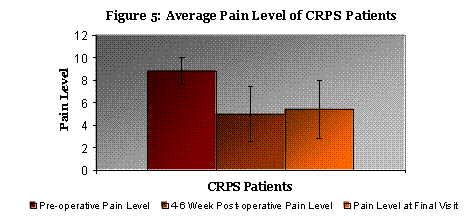Tuesday, October 12, 2004 - 1:40 PM
5723
The Outcome of Peripheral Nerve Stimulation in CRPS
The purpose of this study was to determine the efficacy of peripheral nerve stimulators on reducing pain levels of patients with Complex Regional Pain Syndrome (CRPS). Methods
The 91 patients that we reviewed had been implanted with peripheral nerve stimulators between 1991 and 2003. Patients were identified as either type II or type I CPRS. Pain level on a VAS of 0 to 10 was documented for each patient pre-operatively, at their 4-6 week follow-up visits and at the time of their last documented visits. Finally we documented the number of successive surgeries for revision or removal. For the analysis of all our data we used two-sided t-tests with a 99% confidence interval (Wilcox on signed rank test). We considered differences p<0.05 significant.
Results
Table 1: CRPS Patient Pain Levels on a Scale of 0-10
|
| Average Initial Pain Level | Average Pain Level 4-6 Weeks After PNS Implant | Average Pain Level at Final Visit (mean 31.3 months) |
| Total Patient Population | 8.8 ± 1.2 | 5.0 + 2.5 (p<0.001)* | 5.4 + 2.6 (p<0.001)* |
| Upper Extremity CRPS | 9.0 ± 1.1 | 5.1 ± 2.6 (p<0.001)* | 5.4 ± 2.4 (p<0.001)* |
| Lower Extremity CRPS | 8.6 ± 1.3 | 4.8 ± 2.4 (p<0.001)* | 5.4 ± 2.7 (p<0.001)* |
| Type I CRPS | 8.7 ± 1.4 | 4.7 ± 2.5 (p<0.001)* | 5.4 ± 2.6 (p<0.001)* |
| Type II CRPS | 8.9 ± 1.0 | 5.2 ± 2.5 (p<0.001)* | 5.4 ± 2.6 (p<0.001)* |
*p-values obtained by comparing post-operative pain levels with pre-operative pain The mean age of CRPS patients in our study was 45.5 years (range, 23-80yrs) with 40.7% of the patients being male and 59.3% of the patients being female. The distribution of upper to lower extremity CRPS patients was quite even at 54.9% to 45.1%. There was little difference in the type of CRPS patients as we had 51.6% of patients with type I and 48.3% of the patients with type II CRPS. As demonstrated in figure 5 and table 1 the average CRPS patient received a significant reduction in pain level after the PNS implant (p<0.001). The average reduction at the 4-6 week visit was 43% and at the final visit it was 39%. The average time for the final follow-up was 31.3 months. There was no significant difference between the results for upper and lower extremity patients (p=0.57) or type I and type II CRPS patients (p=0.34) at the 4-6 week follow-up. There was also no difference between the former (p=0.46) and the latter (p=0.71) at the time of the final follow-up. All subgroups of patients received a significant average reduction of pain after PNS implants (see Table 1). 
Five of the 91 patients showed no improvement in pain levels; 4 patients reported increased pain levels after the implantation. Six of the aforementioned nine patients had their PNS removed. An additional 5 patients had their PNS removed due to infection. The average number of surgical revisions necessary (not including battery changes) was 1.6 per patient (range 0-4). These revisions were due to faulty or displaced electrodes, leads, or generators. The average length of time from initial injury until the time of the PNS implant was 51.1 ± 39.0 months. Patients with CRPS for a longer duration reported the same level of pre-operative pain as those patients with more recent cases (p = 0.015). Patients with CRPS for a longer duration experienced as much pain relief from PNS implants after 4-6 weeks (p= 0.014) and at the time of their final follow-up visit (p=0.004).
Discussion The results of our study showed that peripheral nerve stimulators are effective in decreasing the pain level of the average patient with unmanageable CRPS.
Our results demonstrated that there was no significant difference in reduction of pain for patients that had CRPS for longer durations. We continue to work to reduce the revision rate of PNS implants by advancing technological improvements in the device.
View Synopsis (.doc format, 39.0 kb)
See more of Hand, Upper Extremity/Microsurgery
Back to 2004am Complete Scientific Program
